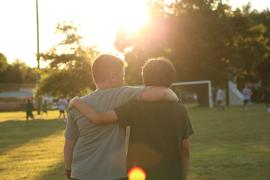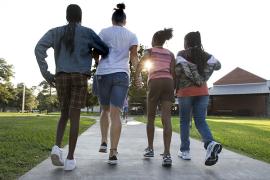Camp Includes Me Series
This feature article is part of an ongoing series of articles in Camping Magazine that will focus on inclusion, diversity, and cross-cultural agility to share in our individual communities and out in the world.
Demographic shifts are bringing a more diverse population of students to schools. As a direct result, camps are now finding themselves in the middle of these drastic demographic shifts. Therefore, there exists a need to move forward with a sense of urgency to ensure that camp directors and counselors further develop the cultural competencies needed to enthusiastically respond to the change.
Cultural competence is having an awareness of one’s own cultural identity and views about difference, and the ability to learn and build on the varying cultural and community norms of students and their families (National Education Association, 2017).
Provided here is research-based insight on the most effective manner in which to build the cultural competencies necessary to ensure the social and emotional development of the children served, placing a major emphasis on the practical application of the content covered in the camp setting.
To be culturally effective does not mean that you are an authority in the values and beliefs of every culture. What it does mean is that you hold a deep respect for cultural differences, are eager to learn, and willing to accept that there are many ways of viewing the world. (Udo, 2011).
Elements of Cultural Proficiency
Interacting with others using what is referred to as the Five Essential Elements of Cultural Proficiency as the standard for behavior and practice is key to experiencing success (Quezada, Lindsey, & Lindsey, 2015). The Essential Elements are:
- Valuing diversity and practicing cultural intelligence
- Having the capacity for cultural assessment
- Managing the dynamics of differences
- Having institutionalized cultural knowledge
- Having developed adaptations to the service (or curriculum development and instructional delivery) reflecting an understanding of cultural diversity
Valuing Diversity
Valuing diversity means respecting differences between and within cultures. At camp, we often presume that a common culture is shared between members of racial, linguistic, and religious groups, but this may not be true. For example, while a group may share a similar physical appearance, language, or spiritual beliefs, their historical and geographical experiences may differ (Community Tool Box, 2017).
Conducting Cultural Self-assessments
The most important actions to be conscious of are usually the ones we take for granted. For instance, physical distance during social interactions varies by culture. If a camp counselor touches someone’s arm during a conversation, this may be misread between cultures (Community Tool Box, 2017).
In this instance, conducting a self-assessment could prove helpful in avoiding cultural conflicts or misunderstandings.
Managing the Dynamic of Differences
Bias due to historical cultural experiences can explain some current attitudes. For example, African Americans and Native Americans, among other groups, have experienced bias and unfair treatment from dominant cultures. Mistrust coming out of negative experiences may be passed on from generation to generation (Community Tool Box, 2017). If you are not cognizant of how you are being perceived (by your peer, a camper, or the camper’s parent(s)/guardian), it is possible that you may underestimate how these dynamics play out as you engage in a genuine attempt to get to know and work successfully with people from diverse backgrounds.
Having Institutionalized Knowledge
Institutionalized knowledge at camp, in part, refers to the fact that staff members must be provided with the professional development training needed to further develop their cultural competencies. Although some sites may have some resemblance of the next suggestion for consideration, I recommend the development of an equity plan that:
- Clearly identifies (on a yearly basis) specific training topics and objectives
- Develops action steps that will be taken to ensure what gets taught is actually implemented
- Identifies proactive plans of action that camp will implement to actively recruit campers and staff from diverse cultural and ethnic backgrounds
- Identifies the measures by which camp will determine the results of their collaborative and intentional efforts
- Identifies, at the national level, other camps/organizations that may serve as models of excellence in this area. The goal is to ensure that we continue to learn from one another.
The implementation of culturally responsive pedagogy at the institutional level is key to supporting your efforts at camp. This means that policies and practices must align with your organization’s vision for creating equitable experiences for all campers.
In addition, and in direct alignment with policy development and the practices of the organization, materials used at each camp should be carefully examined for the purpose of determining if they reflect positive images of people from diverse cultural, linguistic, and ethnic backgrounds, as well as ability levels. Relevant adjustments should be made to the materials given to counselors and campers based on the outcome of the examination of curriculum materials.
Adapting to Diversity
When you recognize, respect, and value all cultures and integrate those values into the system, culturally competent organizations can meet the needs of diverse groups.
Core Competencies
Cultural competence is a journey not an endpoint. You do not arrive. You travel through various parts of the continuum depending on the rate at which you further develop your cultural competencies. To provide additional clarification related to the journey toward developing cultural competencies at your camp, I offer some core competencies that are deeply engrained in culturally responsive leaders.
Competency One: Knowledge of Self-culture
It is important to recognize that we all have a culture. Our culture counts. In addition to embracing our own racial identities, it is imperative that we recognize the impact that our cultural experiences have on the way we view others. Culture is the air you breathe. It is who you are, it is the impact of your childhood and adult experiences (both positive and negative), and it is reflected in the manner in which you interact with other adults and children.
With regard to the campers you serve, naturally an assumption is made about their intellectual capability and backgrounds in part based on your own cultural experiences. Therefore, if you have had limited experiences with people outside of your own culture, it is much more likely that many of your assumptions are not completely accurate.
In addition, if your experience with other cultures is limited, you are also left to develop your beliefs about other cultures based on negative images of marginalized groups that are portrayed in the media through negative stereotyping. So how do you combat your own potential misunderstandings about other cultures and ethnic groups? It starts with a genuine desire to do so. As Shakespeare said, “To thine own self to be true.” It is important to conduct a self-assessment related to your intentions. To be effective, for some it will require a paradigm shift in thinking as it relates to the way in which one views and values people from different backgrounds.
Competency Two: Knowledge of Parent/Camper Culture
What is the best way to accomplish the aforementioned goal? It is by practicing the “policy of intentionality.” You must engage in the process of creating authentic opportunities to get to know the cultures of your campers and their parents/guardians. A simple way to start this process is by learning what matters to them. Find out what excites them about participating in the camp experience and what may cause them to experience anxiety related to doing so. As indicated in the Camping Magazine article “Eight Keys to Attracting and Retaining Hispanic Campers” (Diaz, 2017), some cultures may be biased against sleepovers while others fear that the camp experience might serve to unintentionally undo deeply rooted cultural beliefs instilled in the campers prior to their arrival.
Competency Three: Ability to Identify and Resolve Cultural Conflicts
A key cultural competency is the ability to address cultural conflicts taking place in the camp setting. The goal here is to develop your ability to identify and successfully resolve cultural conflicts that are occurring at camp. Cultural conflicts are misunderstandings that occur as a result of differences related to communication and behavior styles, which can very often serve as counterproductive to supporting your efforts toward creating a more culturally responsive environment.
Competency Four: Knowledge of Culturally Responsive Pedagogy
From a content perspective, the success of campers’ extended experiences is directly tied to your willingness and ability to implement culturally responsive pedagogy. Culturally responsive pedagogy is a camper-centered approach to teaching in which the campers’ unique cultural strengths are identified and nurtured to promote achievement and a sense of well-being (Lynch, 2014).
The goal is to incorporate knowledge of campers’ cultures into the camp curricular-
related experiences and to do so while providing campers access to curricular materials that reflect their cultural experiences and interest levels. The curriculum must first connect with the spirits and the lives of the campers. Unless we reach our students’ hearts, we will have no entry into their minds. (Routman, 2003).
Nontraditional Ways to Involve Parents
In an effort to increase the number of campers from diverse cultural and ethnic backgrounds participating in your camp, it will be necessary to develop a strategic plan of action for doing so. While engaging in the planning process, you will want to take into consideration some of the potential barriers you might run into. For example, some cultures value foreign travel more than the camp experience. Being clear about what the potential roadblocks are and the reasons they exist will decrease the likelihood that you experience frustration during the process.
You will want to solicit insight from the parents of the diverse population of campers currently represented in your camp, or in camps in your area. They can provide very valuable information regarding creative ways to increase the enrollment of campers from diverse cultural backgrounds at your camp.
Call to Action
Please take a moment to reflect on your response to the following question: What must I start doing, stop doing, and continue doing to develop my cultural competencies? Consider your response to this question a call to action. Regardless of your position at camp, you have the power to make a difference. Let’s hold true the words of cultural anthropologist Margaret Mead: “Never doubt that a small group of thoughtful and committed citizens can change the world. It indeed is the only thing that ever has” (Lutkehaus, 2008).
Cultural Conflict Scenarios at CampHere are three examples of cultural conflicts that have occurred in camps across the country. Scenario One: Two African American, female campers wanted to have their braids undone while they were at camp. The Caucasian counselors perceived they were likely asked to make the adjustment to the girls’ hairstyles (as opposed to the African American counselors being asked to do so) because the children were aware that they might not have a full understanding of why doing so would be of great concern to their mothers. After following through with the campers’ request, the counselors were soon made aware of the parents’ displeasure related to their actions. Resolution: In instances of this nature, it would prove beneficial to proactively engage in conversations with parents or guardians regarding their expectations for the management of what can be extremely expensive hairstyles that some campers wear during their time at camp. Scenario Two: Campers were reportedly using the N word during their conversation with one another. Staff whose native language was German indicated that they were not completely aware of the reason or the possible full meaning related to the use of the N word. The counselors attempted to gain some level of understanding about what was occurring by discussing the issue with one another using their native language and in front of the campers. As a result, some of the campers expressed that they were offended by what they were are able to piece together related to the conversation the adults were having. The camp director then engaged in the very difficult task of attempting to explain to the counselors who were new to the country why the campers may have chosen to communicate with one another in the manner described. Resolution: In a situation of this nature, it is important to establish cultural expectations for enrollment and participation in your camp. If this serves as an example of a recurring incident at your respective camp, it is a good idea to address this matter in your camp rules and guidelines. This can be accomplished in a section that describes what is considered acceptable and unacceptable behavior. You will also want to proactively address this topic during your orientation with parents. Scenario Three: Cultural conflicts have been occurring at one camp between campers from the Ukraine and the Hispanic or Latino children. Staff felt the conflicts occurred because the Latino campers believed their Ukrainian peers were speaking negatively about them, and chose to do so in their native language in an effort to reduce the risk of their peers figuring out what they were saying. Resolution: There is great benefit in affording campers the opportunity to engage in conversation using their native language during their camp experience. Doing so helps to relieve potential anxiety they may feel as a result of being in an environment where a greater majority of the campers and staff are Caucasian. Provide opportunities for students to engage in conversations about how to celebrate culture. This can be done by supporting the campers in the use of their native language in conjunction with discussing ways they can become more aware of how their peers feel when they perceive they are being excluded from conversations. Doing so can decrease the likelihood that a group of campers will experience social isolation (which is a form of bullying) during their camp experience. |
Photo courtesy of Camp DeWolfe in Wading River, New York.
References
Community Tool Box. (2018). Section 7. Building culturally competent organizations. Retrieved from ctb.ku.edu
Diaz, S. (2017, September). Eight keys to attracting and retaining Hispanic campers. Camping Magazine. Retrieved from ACAcamps.org/resource-library/camping-magazine/eight-keys-attracting-retaining-hispanic-campers
Lutkehaus, N. C. (2008). Margaret Mead: The making of an American icon. Princeton, NJ: Princeton University Press, p. 261.
Lynch, M. (2011, December 14). What’s culturally responsive pedagogy? Huffington Post, The Blog. Retrieved from huffingtonpost.com/matthew-lynch-edd/culturally-responsive-pedagogy_b_1147364.html
National Education Association. (2017, November 15). Cultural competence for new educators. NEA Today. Retrieved from neatoday.org/schoolme-webinar/cultural-competence-new-educators/?_ga=2.242887106.1543736747.1528406414-454090057.1528406414
Quezada, R., Lindsey, D., & Lindsey, R. (2015, August). 5 elements of cultural proficiency. National Association of Elementary School Principals. Retrieved from naesp.org/communicator-august-2015/5-elements-cultural-proficiency
Routman, R. (2013). Reading essentials: The specifics you need to know to teach reading well. Portsmouth, NH: Heinemann.
Udo, O. O. (2011). What is cultural competency? Cultural Diversity Annual Education. Retrieved from depts.washington.edu/lend/trainees/registration/culturaldiversity.pdf
Sonya Whitaker, EdD, is a highly regarded educator with seven years of experience serving as a school district superintendent. Throughout her career, she has also served as a central office administrator for the largest elementary school district in the state of Illinois. Sonya is a published author and national speaker and has extensive experience as a school administrator and classroom teacher.



